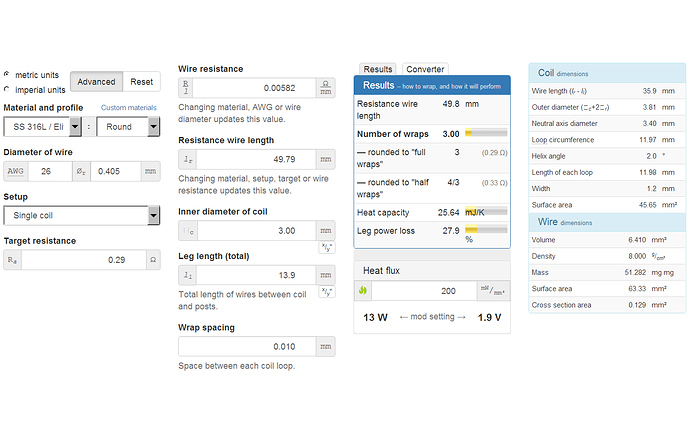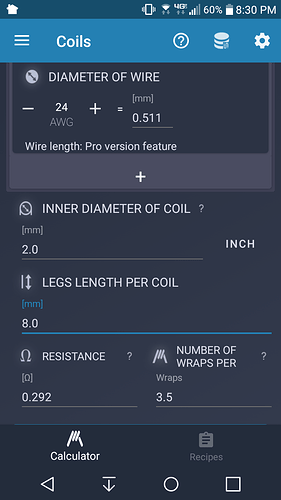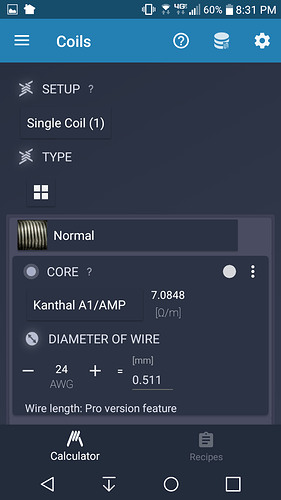Is this what you need?
It’s a coup. The ohms are planning to overthrow the volts and stop the amps in their tracks. So far the watts have remained silent on the issue.
they were doing a show and my internet kept crashing and burning. Trying to figure out how to build a coil that comes out at .29 Ohms on my coil master
Um yeahI have no clue what any of that means. I need the super dumb down version
I have that and still have no clue what any of that means
What is Type of Wire and Gauge used ? What is Inner Diameter (in milliMeters) of the (single only ?) coil desired ? Will the coil leads both extend from the coil in the same direction, or extend in opposite directions?
It would also be helpful to know the “leg length” (in milliMeters) that will need to exist (between the main “body” of the wound coil, and electrical power connections). When designing and winding coils with that low a Resistance value (0.29 Ohm) leg-length measurement becomes increasingly important to take into account
With those things known, we can post (custom URL) Steam Engine Coil Wrapping Calculator values for you. Without knowing the various “parameters” that are listed above, too many variables exist to answer question
.
(Hypothetically only, in example):
Stainless Steel (316L) type wire of #26 Gauge wound with 3mm Inner Diameter and a (relatively small) single-coil only RTA build, total leg-length of ~14mm, with leads that extend in opposite directions from the main body of the coil, 3.0 wraps (3 wraps seems like a minimum number of wraps one might want to use ?):
https://www.steam-engine.org/coil?a=true&mat=ss316l&r=0.29&awg=26&id=3&ll=13.9
.
Decreasing Wire Gauge (to the thicker #24), a 0.329 Ohm coil could be wound using 6.0 wraps:
https://www.steam-engine.org/coil?a=true&mat=ss316l&r=0.329&awg=24&id=3&ll=13.9
.
Changing to (even thicker) #22 Gauge wire, a 0.312 Ohm coil could be wound using ~9.0 wraps:
https://www.steam-engine.org/coil?a=true&mat=ss316l&r=0.312&awg=22&id=3&ll=13.9
.
If one uses Kanthal A1/APM wire, the number of coil-turns needed to achieve a given Resistance value decreases by a factor of 2-3, indicating that Kanthal may not represent a good choice for a ~0.3 Ohm coil.
@authormichellehughes as raven said if you give us a little more info we can help for sure - do you have any plain wire rolls or do you just have pre made coils on hand?
Kanthal 24 Ga sorry my wifi has been horrible all night 10ft
Michelle, please have a look at and if you can (even if estimated) provide the additional data requested.
Kanthal #24 is not looking good (to me).
Changing only those parameters (Type Kanthal A1/APM, Gauge #24) we get 2.16 turns for 0.29 Ohm:
https://www.steam-engine.org/coil?a=true&r=0.29&awg=24&id=3&ll=13.9
3.0 turns (using parameter values that I have been hypothetically using in above calcs) yields 0.367 Ohm:
https://www.steam-engine.org/coil?a=true&r=0.367&awg=24&id=3&ll=13.9
5.0 turns yields 0.546 Ohm:
https://www.steam-engine.org/coil?a=true&r=0.546&awg=24&id=3&ll=13.9
It seems (to me) that something (around) 5 turns (might) be a minimum number of desirable turns ?
6.0 turns of Kanthal #20 yields ~0.283 Ohm (probably the highest Gauge Number that might work out):
https://www.steam-engine.org/coil?a=true&r=0.283&awg=20&id=3&ll=13.9
.
(Perhaps) some of the information that you may provide (might) improve this situation (somewhat).
Okay, thanks for the help guys. I’m just not going to mess with this. Way too complicated LOL
Looks like you have to go down to 2mm to get a few wraps using the 24 gauge wire. And 8mm leads (4mm on each leg) is pretty short. 3 1/2 wraps assumes the leads are on opposite sides of the coil. I’ve never used a coil with that few wraps before but if you space it generously I don’t see why it would not work. The app I used for this is still the free version so I’m not sure if that is why the heat range is so narrow and way below the 46.9 Watts listed. On the free version it seems they throw in one random error that differs depending on the various settings. I’ve never had a problem using it but I like it so I need to go ahead pay the developer. The app is called Vape Tool.
WTF ? Really ? Errors ? Not just “crippled” functionality ? (If so), that is one nasty little “buy a license nag”.
Using a 8mm (total) leg-length (as you have above), and (also) changing to a 2.5mm Inner Diameter,
Steam Engine calculates 3.0 turns yielding 0.292 Ohm (for Michelle’s Kanthal #24 wire):
It seems that one would surely want a rather “hefty” wire thickness for a “super-minimal” 3.0-turn coil !
To me, that’s a clue that the Dev is a douche. And IMO the free app is not to be trusted.
I guess it depends on the severity of the error, but still. A VERY shitty thing to do (especially to a new user, or the lazy; both of which are the most in need of accurate information).
I mean, what if the user is using a mech, and is already unknowingly riding the bleeding edge.
An error in that case could prove disastrous.
Never heard of such a practice. (Perhaps) such is not the case (but somehow it may only seem that is so) ?
(Possibly), numerical rounding-errors (due to the number of significant digits of input data being limited) ?
They tell you up front that the sweet spot is only works in the Pro version. They don’t ever give any errors that would get someone in trouble as far as I can tell but you know there are people that don’t need any help at all to get in trouble. I never gave it much thought that that’s not cool. I’ve been using it for along time now and I find it easier than Steam engine. The pro is only $2.99.
Steam engine forces you to decide the target Ohms up front than tells you how many turns. I don’t like that because the turns is almost always dictated by the deck configuration. I don’t see why both tools can’t allow the user to decide the dependant and independent variable, coil resistance or wraps.
Because in order to satisfy the desired value of the output (dependent) variable, one or more numerical values of the various independent variables would have to change to make such (desired output) be true.
How is the so-called “sweet spot” defined ? An accurate numerical solution is a numerical solution, period.
I guess I’m incorrect say dependant vs. independent. I think perhaps pre-determined may have been correct. I don’t see why the user cannot choose either the coil resistance OR the number of turns to be the pre-determined value.
One could - but things like the Wire Type and Wire Gauge (may) have to change when one is changing any one of the other (independent, input) variable values. Do you see the inherent conceptual problem there ?
The sweet spot is the power within the workable range that provides the best vape experience.
Oh jeez. … The “Vape Tool” developer really, really wants our $3 license fees desperately, it seems … ![]()
… depends on various things (quite hard, and potentially additionally unsafe, to make generalizations about).




